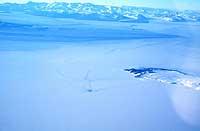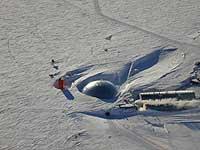The ice of Antarctica, the archive of the climate of the Earth

The ice, once formed, preserves the composition of the current atmosphere and the characteristics of the climate. Antarctica has been accumulating for many years, so its study allows to know data from different eras. Ice research has shown, among other things, the close relationship between the amount of CO2 present in the atmosphere and temperature. The ice mantle they have achieved now is the longest ever extracted and is the perfect record of the climate of the last 740,000 years.
For the extraction of this cylinder, they have only been able to work for two or three months a year, due to the harsh climate. The drilling area has been the place called Dome C, east of the continent, where the temperature is very low in some times of the year. For this reason, they have had to take advantage of the summer of Antarctica to bore it, since it is when they have the atmosphere more "temperate", around the -25ºC.
To combat the outside cold, Dome C scientists have powerful heaters in stores and barracks, can catch hot showers at any time and have a sauna. But despite all these amenities, they have to work hard when they are drilling out.
Slow and hard work
A metal pipe is the main component of the ice extraction apparatus. It has a length of 3.5 meters and a width of 10 centimeters and has the drill at its end. Each time they are drilled a few meters and the ice marrow is inside the tube. Then bring the tube to the surface and pull out the medulla, record it and keep it and return to the hole to remove the next meters.

Drilling must be careful, can occur at any time and technical problems. In the initial meters, for example, there are many air bubbles, so the ice is much slower. When they emerge, moreover,
A pressure drop can cause the explosion of ice and reduce it completely. On the other hand, ice princes can hinder the whole mechanism. This occurred in Dome C at the time of drilling of 1998-99 and could not recover the tube. Consequently, they had to leave the hole and start somewhere else from the beginning, which meant a great delay.
As the work progresses, the whole process is becoming longer. In Dome C, when they were under three thousand meters, they only needed an hour to bring the device to surface.
The aim of the project was to drill the entire ice sheet, but when they reached 3,100 meters they had another problem. Barely 100 meters were missing and the ice was found near the melting point. Apparently, it was the influence of a geothermal heat source on the ground.
This was a great risk for the drill, since this ice could be recristalized and block the entire mechanism. They decided to suspend the work, but for the month of November they will prepare and they will retake the missing meters. The research is underway
Meanwhile, they begin to investigate the fragments of those 3.1 kilometers. The work is being carried out within the European EPICA project, and the pieces of ice extracted have been carefully sent to various European laboratories. A quarter of all the cylinder pieces have been left in Antarctica to replace it in case of a problem.
Laboratory scientists, even if they are in more temperate areas, will also need winter clothing and suitable material to work on giant freezers. In the analysis of the samples takes special importance the ancient air trapped in the ice. They are measuring everything, carbon dioxide, methane, nitrogen oxides, nitrogen isotopes and oxygen.
Laboratory research has only begun, but the first results have already been published. One of them is the time that covers ice, from today until 740,000 years ago.

In addition, data have been obtained on a particularly important period. This period extends between 425,000 and 395,000 years, when the orbit of the Earth was, for the last time, the same as today.
The first data show that that time, like the current one, was a warm interglacial period and that the climate and composition of the atmosphere were very similar. According to the researchers, the amount of CO2 per hour was the same as that of the industrial era. According to the interpretation of these data, if there were no global warming effects, we would have to wait 16,000 years to see the next glaciation.
Studies will be extended and scientists expect to obtain relevant information for future more accurate predictions. One of its main goals will be to better understand the influence of greenhouse gases.
Published in 7K.
Buletina
Bidali zure helbide elektronikoa eta jaso asteroko buletina zure sarrera-ontzian












